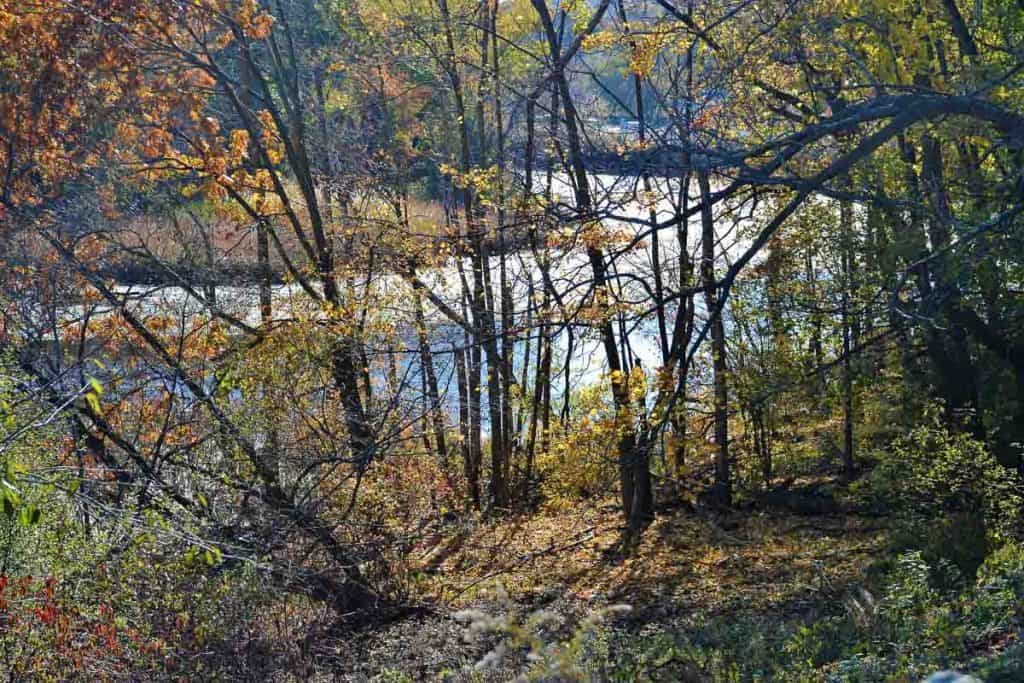Here’s what’s blooming in town this week to make your walks more enjoyable
The frosty nights we had over the weekend have brought a change to the landscape. There are still some very vivid foliage colors, but many leaves have changed to muted tones of caramel, bronze, cranberry and pumpkin as they encounter the colder temperatures. Some garden flowers have given up for the season, but others are rebounding in the warm daytime temperatures. Now that foliage is falling, the small flowers of the common witch hazel (Hamamelis virginiana) can more clearly be seen along Pine Tops and Hemlock Road in Breakheart Reservation although they have actually been blooming for several weeks already.
Walking and driving around town this week, you can see many seasonal transitions. On Monday morning the center was a beehive of activity as holiday lights were being installed at the rotary in Saugus Center and on the honey locusts (Gleditsia triacanthos) lining Central Street. Doorways on several homes have Christmas wreaths up this week while just a few doors away jack-o-lanterns may still be smiling from the steps. A few houses have seasonal garden flags waving with turkeys or cornucopias to celebrate the harvest and thanksgiving. It may take a while to get used to the sun setting earlier in the afternoon, but most of us appreciate not having to get up in the dark in the morning as we reacclimate ourselves to standard time. Pleasant weather later this week encouraged many to gather at the corner of Winter Street to appreciate the veterans, and we will soon be thankful for the opportunity to gather with relatives and friends at Thanksgiving.
Hickories (Carya spp.) are very common in the woods around here and provide some much-needed wildlife food since there were far fewer acorns produced this year than last fall. Squirrels have been eagerly gathering hickory nuts as well as those of the related walnuts (Juglans spp.) to supply them with energy through the winter. We have several similar hickory species in New England, but shagbark hickory (Carya ovata) may be the best known, and older trees are easy to recognize even when the leaves are too high up to be easily examined. On older trees the “shaggy bark” is clearly seen, although it takes many years of growth for the trees to develop it. We also see quite a bit of pignut hickory (Carya glabra), which has less rough bark and which got its name because the nuts are not as sweet. Both have pinnately compound leaves with five leaflets each and beautiful yellow to golden fall color. In the accompanying photo, the entire leaf has fallen to the ground intact, but it is not unusual for individual leaflets to fall separately from the petiole, making it more difficult to recognize the true leaf shape. On hickory, walnut and honey locust trees, the leaflets of each compound leaf are attached to each other by small petiole-like connections and often do not fall as a single unit when autumn arrives. There are a few other hickory species occasionally found in the Northeast, and many people will be enjoying a pie this month made from the nuts of the closely related pecan (Carya illinoiensis). Pecans’ native range is somewhat south and west of New England, but it is hardy enough to grow here and is occasionally planted in our area. Hickories may be common in the woods, but they are not commonly sold in nurseries because of their long taproot, which makes them hard to transplant. I do know of one mature hickory that is a street tree on Jasper Street, large enough to show the shaggy bark – it was a stunning gold a few weeks ago, but most of its leaves are gone now. It seems an appropriate tree to usher in the cozy season, with the scent of dinner being smoked over a hickory wood fire, and snacks of tasty hickory nuts being savored by people and wildlife.
Editor’s Note: Laura Eisener is a landscape design consultant who helps homeowners with landscape design, plant selection and placement of trees and shrubs, as well as perennials. She is a member of the Saugus Garden Club and offered to write a series of articles about “what’s blooming in town” shortly after the outbreak of the COVID-19 pandemic. She was inspired after seeing so many people taking up walking.






